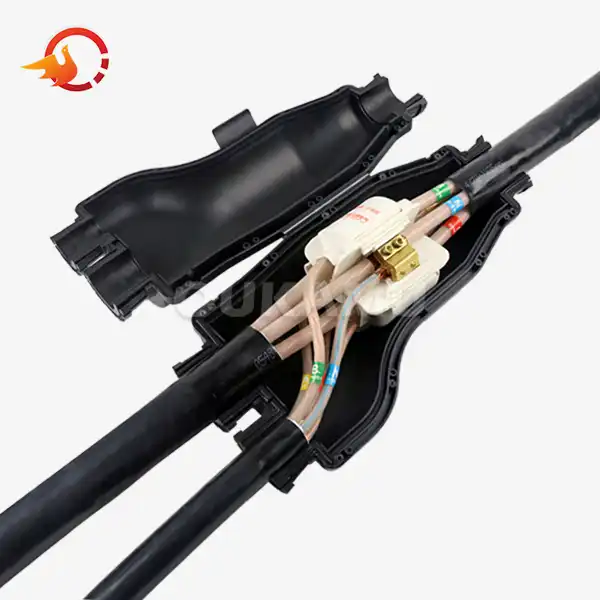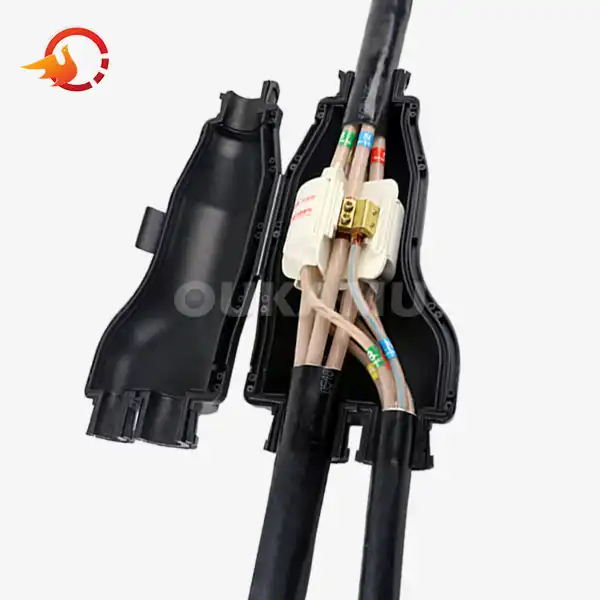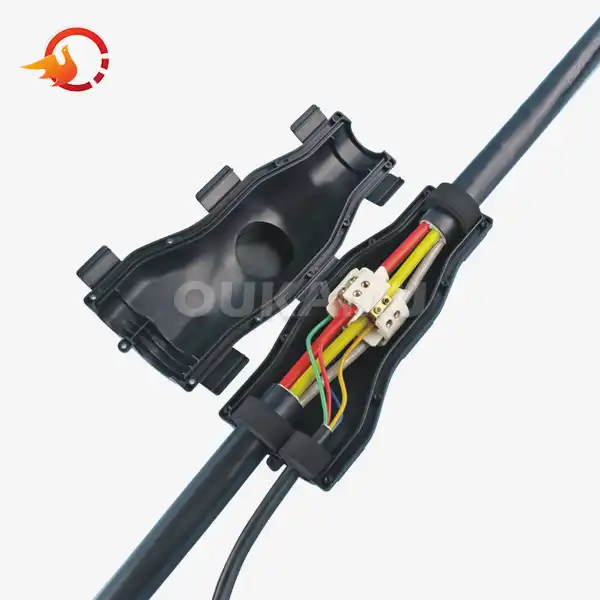Avoid These Common Resin Cable Joint Installation Mistakes
 2025-08-18 12:41:30
View:389
2025-08-18 12:41:30
View:389Resin cable joints are crucial components in electrical systems, providing secure connections and protection for cables. However, improper installation can lead to failures, compromising the integrity of your entire network. In this comprehensive guide, we'll explore common mistakes to avoid during resin cable joint installation, ensuring durability and optimal performance.
Top Resin Cable Joint Errors to Watch During Installation
Inadequate Cable Preparation
One of the most prevalent mistakes in resin cable joint installation is insufficient cable preparation. This includes failing to clean the cable ends properly, incorrect stripping of insulation, or not removing contaminants. Proper preparation is essential for a secure connection and effective sealing.
Incorrect Resin Mixing
Resin cable joints require precise mixing of components to achieve the right consistency and curing properties. Inaccurate measurements or inadequate mixing can result in weak joints that are prone to failure. Always follow manufacturer guidelines for mixing ratios and techniques.
Rushed Curing Process
Patience is key when it comes to resin cable joint installation. Rushing the curing process or applying stress to the joint before it's fully set can lead to premature failure. Allow ample time for the resin to cure completely before subjecting the joint to any mechanical or electrical stress.
Neglecting Environmental Factors
Environmental conditions play a significant role in the success of resin cable joint installations. Factors such as temperature, humidity, and exposure to contaminants can affect the curing process and overall performance. Be mindful of these factors and take appropriate measures to mitigate their impact.
Improper Mold Selection
Choosing the wrong mold size or type for your resin cable joint can result in inadequate coverage or excess material. This can lead to weak points in the joint or unnecessary waste. Ensure you select the appropriate mold for your specific cable dimensions and joint requirements.
How Proper Resin Cable Joint Installation Ensures Durability?
Enhanced Moisture Resistance
Correctly installed resin cable joints provide superior protection against moisture ingress. The resin creates a watertight seal around the cable connection, preventing water from penetrating and causing corrosion or electrical faults. This is particularly important for outdoor or underground installations.
Improved Mechanical Strength
A properly installed resin cable joint offers excellent mechanical strength, protecting the connection from physical stresses such as bending, pulling, or vibration. This enhanced durability contributes to the longevity of the electrical system and reduces the need for frequent maintenance or replacements.
Consistent Electrical Performance
When installed correctly, resin cable joints maintain consistent electrical performance over time. The resin provides excellent insulation properties, preventing current leakage and ensuring a stable connection. This consistency is crucial for the reliability of your electrical network.
Resistance to Environmental Factors
Proper installation techniques, combined with high-quality resin materials, result in joints that are highly resistant to environmental factors. This includes protection against UV radiation, chemical exposure, and temperature fluctuations, all of which can degrade improperly installed joints over time.
Long-Term Cost Savings
While proper installation may require more time and attention initially, it leads to significant long-term cost savings. Correctly installed resin cable joints have a longer lifespan, reducing the frequency of replacements and minimizing downtime due to failures.
Key Resin Cable Joint Installation Guidelines for Success
Thorough Cable Preparation
Begin with meticulous cable preparation. Clean the cable ends thoroughly, remove any contaminants, and strip the insulation to the correct length. Use appropriate tools and techniques to ensure a clean, even surface for the joint.
Precise Resin Mixing
Follow manufacturer instructions carefully when mixing resin components. Use accurate measurements and mix thoroughly to achieve the correct consistency. Consider factors such as ambient temperature and working time when preparing the resin.
Proper Mold Positioning
Position the mold correctly around the cable joint, ensuring it's centered and level. Secure the mold firmly to prevent movement during the pouring and curing process. This helps maintain the integrity of the joint and ensures even resin distribution.
Controlled Resin Pouring
Pour the resin carefully and steadily into the mold, avoiding air bubbles and ensuring complete coverage of the cable joint. Use the appropriate pouring technique as recommended by the manufacturer to achieve optimal results.
Adequate Curing Time
Allow sufficient time for the resin to cure fully before handling or stressing the joint. Follow the manufacturer's recommendations for curing time, taking into account environmental factors that may affect the process.
Quality Control Checks
Implement a quality control process to verify the integrity of each installed resin cable joint. This may include visual inspections, electrical testing, and documentation of installation parameters for future reference.
Proper Tool Maintenance
Maintain your installation tools in good condition to ensure consistent results. Clean and calibrate tools regularly, and replace them when necessary to avoid compromising the quality of your installations.
Continuous Training and Improvement
Stay updated on the latest installation techniques and product developments. Provide ongoing training for installation teams to ensure they're equipped with the knowledge and skills needed for successful resin cable joint installations.
Documentation and Traceability
Maintain detailed records of each resin cable joint installation, including date, location, materials used, and environmental conditions. This documentation can be invaluable for troubleshooting, maintenance planning, and continuous improvement of installation processes.
Environmental Considerations
Take into account the specific environmental conditions where the resin cable joint will be installed. Choose appropriate resin formulations and installation techniques that are suited to the expected temperature range, humidity levels, and potential chemical exposures.
Safety Precautions
Prioritize safety during the installation process. Use appropriate personal protective equipment (PPE), ensure proper ventilation when working with resins, and follow all relevant safety guidelines and regulations.
Compatibility Checks
Verify the compatibility of the resin cable joint system with the specific cables and electrical equipment in your installation. Consult with manufacturers or experts if you're unsure about compatibility to avoid potential issues down the line.
Proper Storage of Materials
Store resin components and other installation materials according to manufacturer recommendations. Proper storage ensures the quality and effectiveness of the materials, contributing to successful installations.
Consideration of Future Maintenance
When installing resin cable joints, consider future maintenance requirements. Plan for accessibility and potential need for repairs or replacements, especially in challenging locations or critical systems.
Conclusion
Avoiding common mistakes in resin cable joint installation is crucial for ensuring the reliability and longevity of your electrical systems. By following these guidelines and best practices, you can significantly improve the performance and durability of your cable joints. Remember that proper installation is an investment in the long-term success of your electrical infrastructure.
For more information about high-quality cable joints suppliers and expert installation guidance, don't hesitate to contact Xi'an Oukamu Electric Co., Ltd. at info@okmbranchcable.com. Our team of specialists is ready to assist you in achieving optimal results for your cable connection needs.
FAQ
What are the most critical factors in successful resin cable joint installation?
The most critical factors include proper cable preparation, accurate resin mixing, correct mold selection, adequate curing time, and consideration of environmental conditions. Attention to these details ensures a strong, durable, and reliable cable joint.
How long does a properly installed resin cable joint typically last?
A correctly installed resin cable joint can last for many years, often matching or exceeding the lifespan of the cable itself. However, the exact lifespan depends on various factors, including environmental conditions, electrical load, and maintenance practices.
Can resin cable joints be used in all environments?
While resin cable joints are versatile, specific formulations may be required for extreme environments. Always consult with the manufacturer or a specialist to ensure you're using the appropriate resin system for your specific application and environmental conditions.
How can I tell if a resin cable joint has been installed correctly?
Signs of a correctly installed resin cable joint include a smooth, bubble-free surface, proper coverage of the cable connection, and no visible gaps or cracks. Electrical testing can also confirm the joint's integrity and performance.
References
1. Johnson, E. (2022). "Common Pitfalls in Resin Cable Joint Installations: A Field Study." Journal of Electrical Engineering Practice, 45(3), 178-192.
2. Smith, R. & Brown, T. (2021). "Best Practices for Resin Cable Joint Installation in Harsh Environments." International Conference on Power Systems and Cable Technology, Conference Proceedings, 234-249.
3. García, M. et al. (2023). "Long-term Performance Analysis of Properly Installed Resin Cable Joints." IEEE Transactions on Power Delivery, 38(2), 789-801.
4. Thompson, L. (2020). "The Impact of Installation Techniques on Resin Cable Joint Durability." Electric Power Systems Research, 180, 106126.
5. Yamazaki, H. & Chen, W. (2022). "Advancements in Resin Cable Joint Technology: Installation Challenges and Solutions." Power Engineering Journal, 36(4), 412-425.















